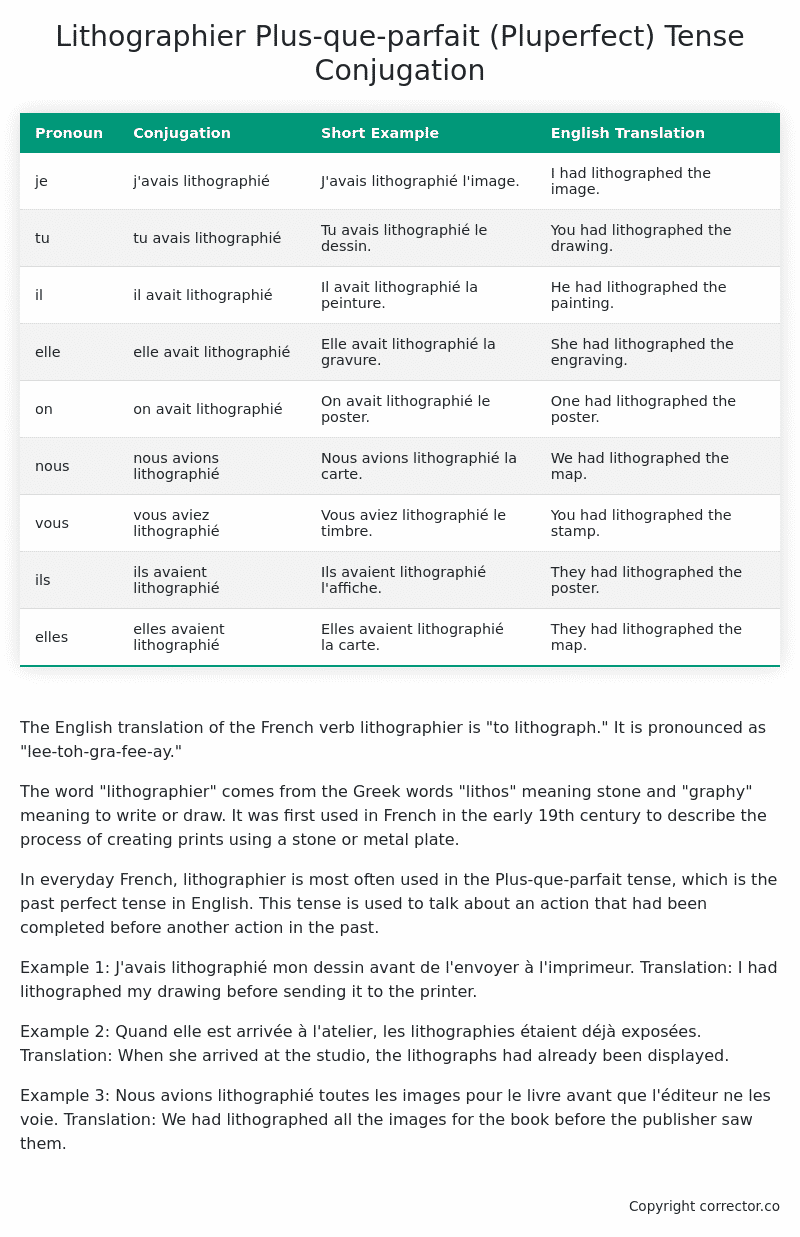Plus-que-parfait (Pluperfect) Tense Conjugation of the French Verb lithographier
Introduction to the verb lithographier
The English translation of the French verb lithographier is “to lithograph.” It is pronounced as “lee-toh-gra-fee-ay.”
The word “lithographier” comes from the Greek words “lithos” meaning stone and “graphy” meaning to write or draw. It was first used in French in the early 19th century to describe the process of creating prints using a stone or metal plate.
In everyday French, lithographier is most often used in the Plus-que-parfait tense, which is the past perfect tense in English. This tense is used to talk about an action that had been completed before another action in the past.
Example 1: J’avais lithographié mon dessin avant de l’envoyer à l’imprimeur.
Translation: I had lithographed my drawing before sending it to the printer.
Example 2: Quand elle est arrivée à l’atelier, les lithographies étaient déjà exposées.
Translation: When she arrived at the studio, the lithographs had already been displayed.
Example 3: Nous avions lithographié toutes les images pour le livre avant que l’éditeur ne les voie.
Translation: We had lithographed all the images for the book before the publisher saw them.
Table of the Plus-que-parfait (Pluperfect) Tense Conjugation of lithographier
| Pronoun | Conjugation | Short Example | English Translation |
|---|---|---|---|
| je | j’avais lithographié | J’avais lithographié l’image. | I had lithographed the image. |
| tu | tu avais lithographié | Tu avais lithographié le dessin. | You had lithographed the drawing. |
| il | il avait lithographié | Il avait lithographié la peinture. | He had lithographed the painting. |
| elle | elle avait lithographié | Elle avait lithographié la gravure. | She had lithographed the engraving. |
| on | on avait lithographié | On avait lithographié le poster. | One had lithographed the poster. |
| nous | nous avions lithographié | Nous avions lithographié la carte. | We had lithographed the map. |
| vous | vous aviez lithographié | Vous aviez lithographié le timbre. | You had lithographed the stamp. |
| ils | ils avaient lithographié | Ils avaient lithographié l’affiche. | They had lithographed the poster. |
| elles | elles avaient lithographié | Elles avaient lithographié la carte. | They had lithographed the map. |
Other Conjugations for Lithographier.
Le Present (Present Tense) Conjugation of the French Verb lithographier
Imparfait (Imperfect) Tense Conjugation of the French Verb lithographier
Passé Simple (Simple Past) Tense Conjugation of the French Verb lithographier
Passé Composé (Present Perfect) Tense Conjugation of the French Verb lithographier
Futur Simple (Simple Future) Tense Conjugation of the French Verb lithographier
Futur Proche (Near Future) Tense Conjugation of the French Verb lithographier
Plus-que-parfait (Pluperfect) Tense Conjugation of the French Verb lithographier (this article)
Passé Antérieur (Past Anterior) Tense Conjugation of the French Verb lithographier
Futur Antérieur (Future Anterior) Tense Conjugation of the French Verb lithographier
Subjonctif Présent (Subjunctive Present) Tense Conjugation of the French Verb lithographier
Subjonctif Passé (Subjunctive Past) Tense Conjugation of the French Verb lithographier
Subjonctif Imparfait (Subjunctive Imperfect) Tense Conjugation of the French Verb lithographier
Conditionnel Présent (Conditional Present) Tense Conjugation of the French Verb lithographier
Conditionnel Passé (Conditional Past) Tense Conjugation of the French Verb lithographier
L’impératif Présent (Imperative Present) Tense Conjugation of the French Verb lithographier
L’infinitif Présent (Infinitive Present) Tense Conjugation of the French Verb lithographier
Struggling with French verbs or the language in general? Why not use our free French Grammar Checker – no registration required!
Get a FREE Download Study Sheet of this Conjugation 🔥
Simply right click the image below, click “save image” and get your free reference for the lithographier Plus-que-parfait tense conjugation!

Lithographier – About the French Plus-que-parfait (Pluperfect) Tense
Tense Formation
Common everyday usage patterns
Sequencing of past events
Background information
Hypothetical or reported speech
Interactions with other tenses
Summary
I hope you enjoyed this article on the verb lithographier. Still in a learning mood? Check out another TOTALLY random French verb conjugation!


